China has a very large landscape which is home to a great variety of wildlife. China has the third-largest number of mammals in the world. Animals in China such as the giant panda are endemic to China. Some of the animals that are native to China include the Asian elephant, sable, dugong, Pallas cat, North China leopard, binturong, clouded leopard, Tibetan macaque, golden snub-nosed monkey, and the giant panda.
1. Giant Panda
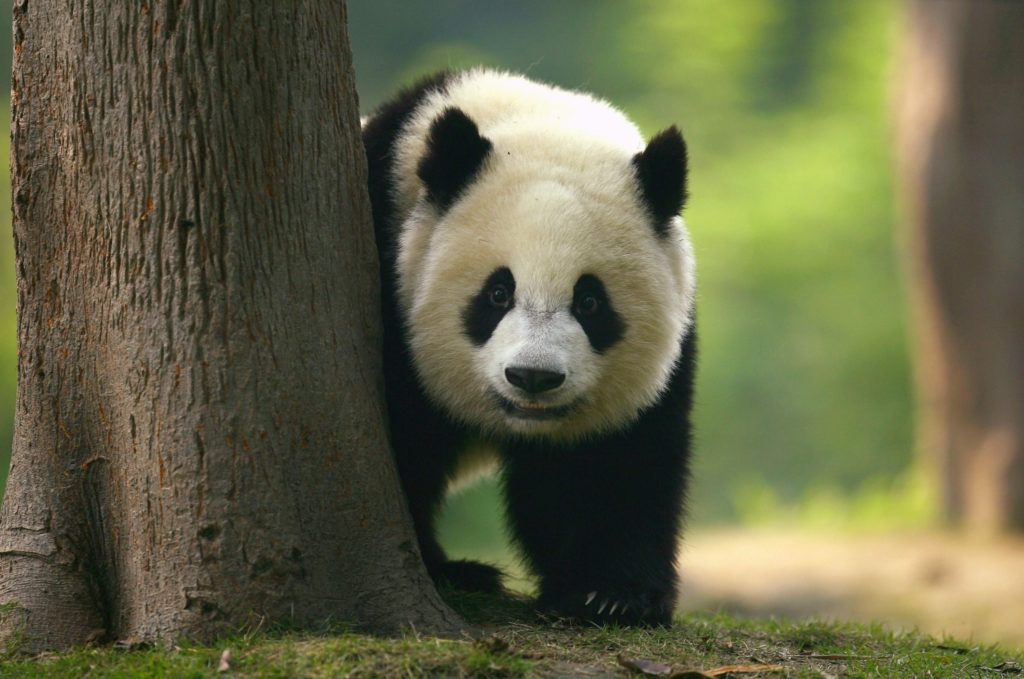
The giant panda (Ailuropoda melanoleuca) also known as panda bear or simply panda, is a bear native to south-central China. It is easily recognized by the large, distinctive black patches around its eyes, over the ear, and across its round body. The name “giant panda” is sometimes used to distinguish it from the distantly related red panda. Though it belongs to the order Carnivora, the giant panda is a folivore, with bamboo shoots and leaves making up more than 99% of its diet. Giant pandas in the wild will occasionally eat other grasses, wild tubers, or even meat in the form of birds, rodents, or carrion. In captivity, they may receive honey, eggs, fish, yams, shrub leaves, oranges, or bananas along with specially prepared food.
2. Golden Snub-Nosed Monkey
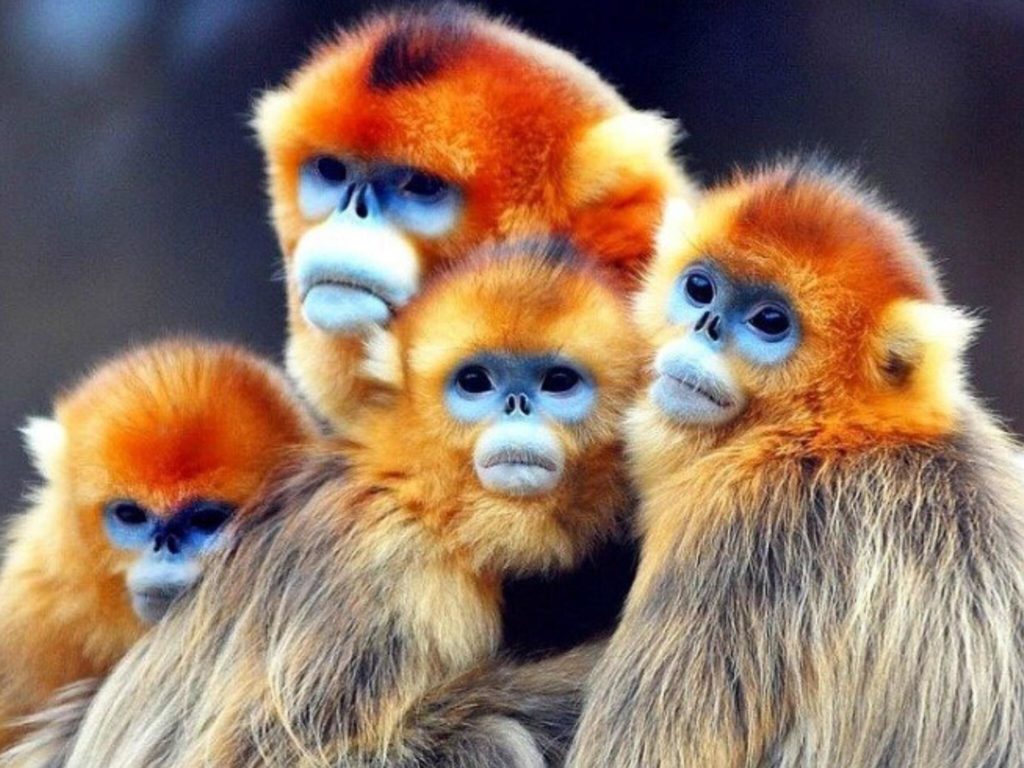
The golden snub-nosed monkey (Rhinopithecus roxellana) is an Old World monkey in the subfamily Colobinae. It is endemic to a small area in temperate, mountainous forests of central and Southwest China. They inhabit these mountainous forests of Southwestern China at elevations of 1,500-3,400 m above sea level. The Chinese name is Sichuan golden hair monkey (四川金丝猴). It is also widely referred to as the Sichuan snub-nosed monkey. Of the three species of snub-nosed monkey animal in China, the golden snub-nosed monkey is the most widely distributed throughout China.
Snow occurs frequently within its range and it can withstand colder average temperatures than any other non-human primates. Its diet varies markedly with the seasons, but it is primarily a herbivore with lichens being its main food source. It is diurnal and largely arboreal, spending some 97% of its time in the canopy. There are three subspecies. Population estimates range from 8,000 to 15,000 and it is threatened by habitat loss.
3. Tibetan Macaque
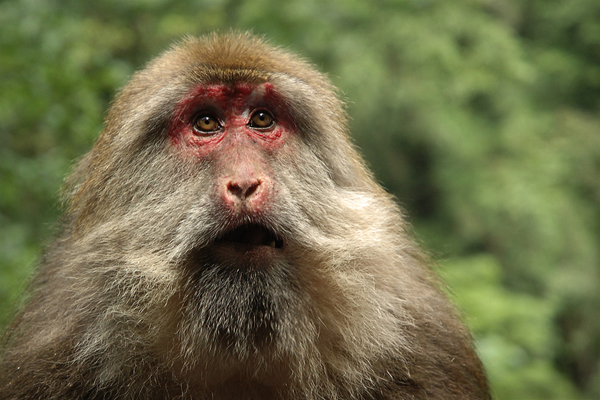
The Tibetan macaque (Macaca thibetana), also known as the Chinese stump-tailed macaque or Milne-Edwards’ macaque, is found from eastern Tibet east to Guangdong and north to Shaanxi in China. It has also been reported from northeastern India. This species lives in subtropical forests (mixed deciduous to evergreen) at altitudes from 800 to 2,500 m (2,600 to 8,200 ft) above sea level.
The Tibetan macaque is the largest species of macaque and one of the largest monkeys found in Asia. Only the probosci’s monkey and the larger species of gray langur come close to match their size among Asian monkeys. Males are the larger sex, commonly attain a weight of 13 to 19.5 kg (29 to 43 lb) and length of 61 to 71 cm (24 to 28 in) long, with a maximum record weight of 30 kg (66 lb). Females, in contrast, weigh 9 to 13 kg (20 to 29 lb) and measure 49 to 63 cm (19 to 25 in) long. The stump-like tail adds only 4 to 14 cm (1.6 to 5.5 in), with females having a considerably shorter tail. The fur is well-suited to the species’ cold environments being long, dense and brown on the back with creamy-buff to the grey colouration on the underparts. Some adults are quite dark brown on the back, while others are a sandy yellowish-brown colour. They have a prominent, pale-buff beard and long whiskers, but have a hairless face. The face is pale pinkish in males but is a more vivid, reddish-pink in females. The infants have silver-and-black fur that changes to their adult colour at the age of two.
The Tibetan macaque lives in mixed-sex groups. In their complex social system, females remain for life in their natal group, but males disperse shortly after their adolescence (at about 8 years old). Macaque societies are hierarchical, with higher-ranking males getting better access to the resources, namely food and sexually-receptive females. Alpha males dominate the group, being those that are typically large, strong and newly mature. As they age, males tend to gradually lose their social standing and are frequently subject to challenges for dominance from other males. Such conflicts are frequently quite violent and males may kill each other in battle. Studies of Tibetan macaques at Mount Emei and Huangshan Mountains, China, found the average tenure for an alpha male only lasted about one year. When troop size becomes quite large (in the 40 to 50 range) and competition grows over increasingly stretched resources, some individuals (males, females and juveniles) split from the main group to form a new, smaller group, known as ‘fissioning’ and move on to a different home range. Usually, it is the lowest-ranking individuals that will split from the main group.
Females first breed at around five years of age. The gestation period is six months with a single offspring being produced at each pregnancy. Most infants being born in January and February. Young macaques are nursed for a year and may continue to do so longer if the female does not give birth again the following year. Males of the group may also be involved in alloparenting care.
This diurnal species spends most of its time on the ground, where it forages for leaves, fruit, grass and, to a lesser extent, flowers, seeds, roots and insects. When available, bamboo shoots, fruits and leaves are particularly favoured.
4. Clouded Leopard
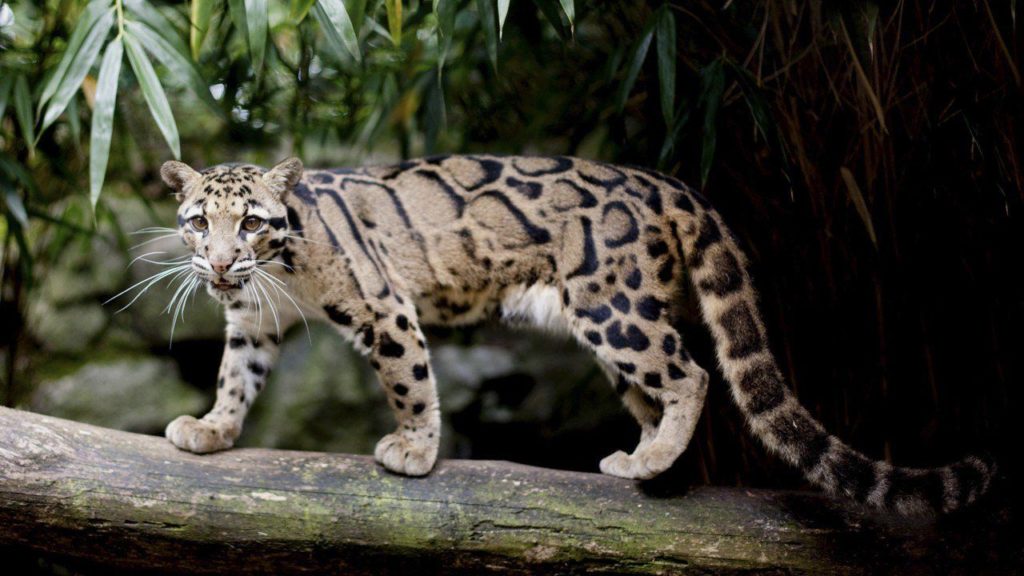
The clouded leopard (Neofelis nebulosa) is a medium-sized wild cat occurring from the Himalayan foothills through mainland Southeast Asia into southern China. Since 2008, it is listed as Vulnerable on the IUCN Red List. Its total population is suspected to be fewer than 10,000 mature individuals, with a decreasing population trend, and no single population numbering more than 1,000 adults.
It is also called mainland clouded leopard to distinguish it from the Sunda clouded leopard (N. diardi). It is the state animal of the Indian state of Meghalaya.
5. Binturong
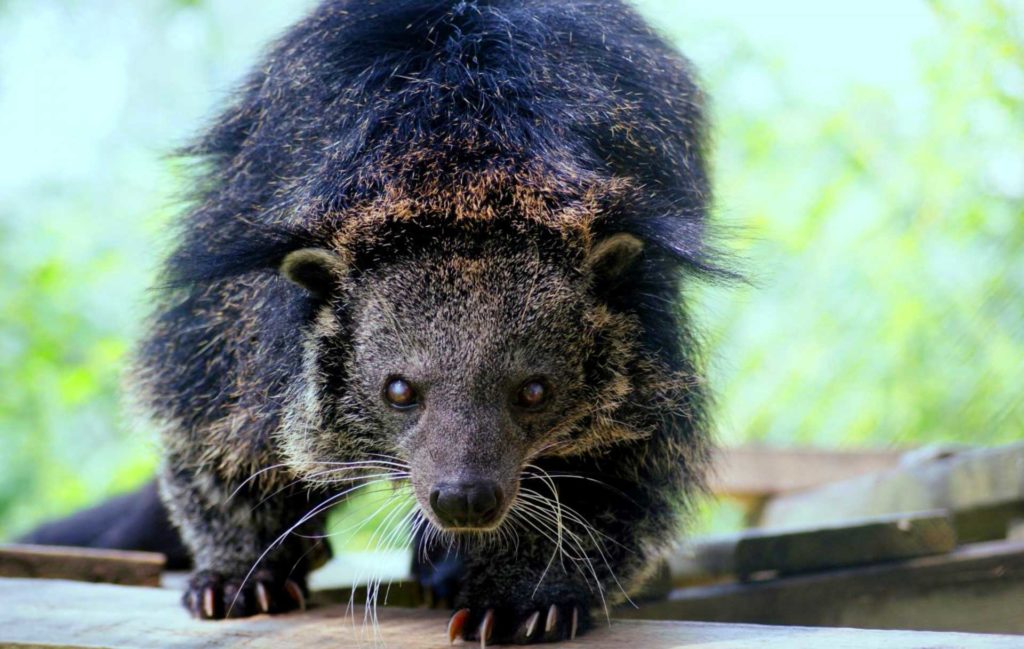
The binturong(Arctictis binturong), also known as bearcat, is a viverrid native to South and Southeast Asia. It is uncommon in much of its range and has been assessed as Vulnerable on the IUCN Red List because of a declining population trend that is estimated at more than 30% since the mid-1980s.
The binturong occurs from India, Nepal, Bangladesh, Bhutan, Myanmar, Thailand, Malaysia to Laos, Cambodia, Vietnam and Yunnan in China, and from Sumatra, Kalimantan and Java in Indonesia to Palawan in the Philippines. It is confined to the tall forest. In Assam, it is common in foothills and hills with good tree cover, but less so in the forested plains. It has been recorded in Manas National Park, in Dulung and Kakoi Reserved Forests of the Lakhimpur district, in the hill forests of Karbi Anglong, North Cachar Hills, Cachar and Hailakandi Districts. In Myanmar, binturongs were photographed on the ground in Tanintharyi Nature Reserve at an elevation of 60 m (200 ft), in the Hukaung Valley at elevations from 220–280 m (720–920 ft), in the Rakhine Yoma Elephant Reserve at 580 m (1,900 ft) and three other sites up to 1,190 m (3,900 ft) elevation. In Thailand’s Khao Yai National Park, several individuals were observed feeding in a fig tree and on a vine. In Laos, they have been observed in an extensive evergreen forest. In Malaysia, binturongs were recorded in the secondary forest surrounding a palm estate that was logged in the 1970s. In Palawan, it inhabits primary and secondary lowland forest, including grassland–forest mosaic from sea level to 400 m (1,300 ft).
6. North China Leopard
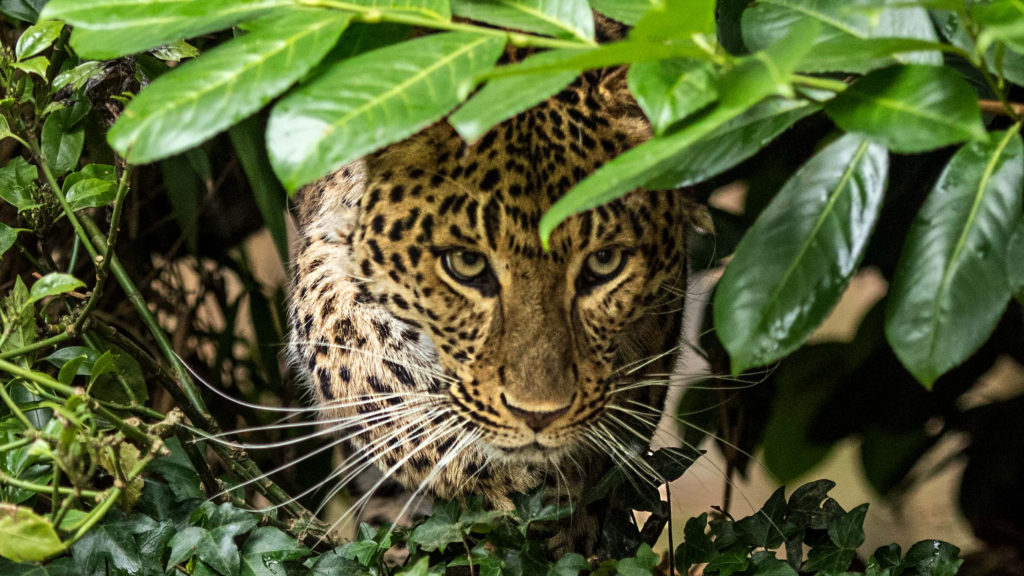
When an animal bears a country’s name, it tends to stand apart from other subspecies. But the North China leopards may lose its uniqueness by being subsumed under its northern neighbour the Amur leopards.
The North China leopards (Panthera pardus japonensis) are graceful and powerful big cats that roam the mountains and forests of northern China, the habitat of the Amur leopards (Panthera pardus Orientalis). However, because there’s no biogeographical barrier between these two leopards, the Cat Classification Task Force of the Cat Specialist Group placed the North China leopard under the classification of Amur leopard in 2017.
But the new classification remains controversial due to the lack of molecular-level evidence.
Despite their habitats being close to each other, the two big cats vary in their fur and size. The North China leopard has a tan coat, while the Amur leopard’s thick fur is cream-coloured, especially in winter. The length of the North China leopard is about 170-210 cm, and that of the Amur leopard 180-240 cm.
However, some people don’t like the new classification. The Amur leopard is a critically-endangered species on the IUCN Red List with only 84 adults and 19 cubs in the wild. If the North China leopards are included in it, the Amur leopard may become an endangered species.
The new classification may also have some impact on Amur leopard conservation and vice versa for the North China leopard.
The number of North China leopard is unclear due to insufficient data. In 2018, Chinese researchers identified two habitats of the North China leopard in Shanxi and Shaanxi provinces.
According to researcher Feng Limin, the Ziwuling forest region in Shaanxi Province, where 28 leopards have been recorded, is the most densely populated region for the leopard.
The leopard’s competitors like tigers, wolves and black bears are barely found in that region, making it the top predator in Shannxi. But the last time the North China leopard was recorded in Beijing was in 2005.
The animal’s main threats are conflicts between human beings and animals, poaching for wildlife trade, habitat loss or fragmentation and low prey numbers. Some people worry the new classification may influence the protection work for the North China leopard.
7. Pallas Cat
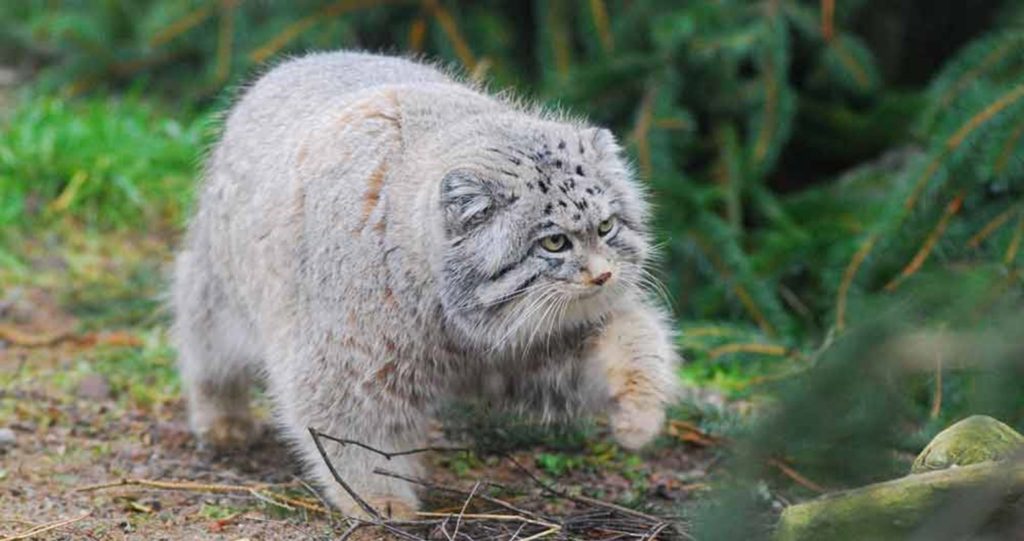
Pallas’s cat, also called manul, is a small wild cat with a broad, but fragmented distribution in the grasslands and montane steppes of Central Asia. It is negatively affected by habitat degradation, prey base decline and hunting, and has therefore been classified as Near Threatened on the IUCN Red List since 2002.
The Pallas’s cat is about the size of a domestic cat. Its body is 46 to 65 cm (18 to 26 in) long and its tail 21 to 31 cm (8.3 to 12.2 in). It weighs 2.5 to 4.5 kg (5.5 to 9.9 lb). The combination of its stocky posture and long, dense fur makes it appear stout and plush. Its fur is ochre with dark vertical bars on the torso and forelegs. The winter coat is greyer and less patterned than the summer coat. There are clear black rings on the tail and dark spots on the forehead. The cheeks are white with narrow black stripes running from the corners of the eyes. The chin and throat are also white, merging into the greyish, silky fur of the underparts. Concentric white and black rims around the eyes accentuate their rounded shape. The legs are proportionately shorter than those of other cats, the ears are set very low and wide apart, and the claws are unusually short. The face is shortened compared with other cats, giving it a flattened look. The pupils are circular rather than vertical slits. The short jaw has fewer teeth than is typical among cats, with the first pair of upper premolars missing, but the canine teeth are large.
8. Dugong
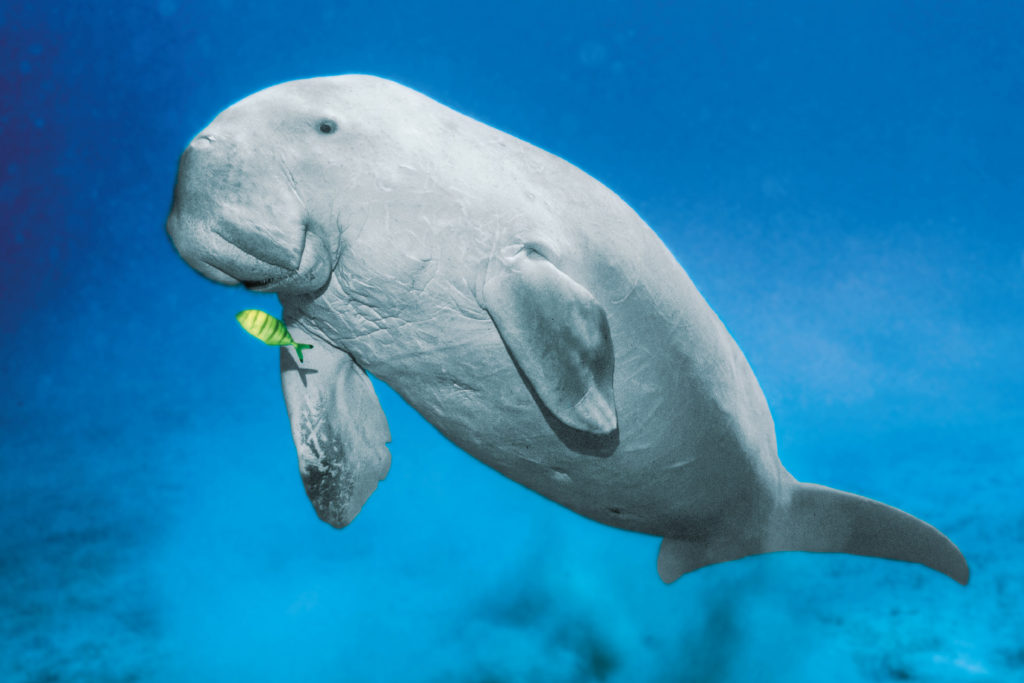
The dugong is a medium-sized marine mammal. It is one of four living species of the order Sirenia, which also includes three species of manatees. It is the only living representative of the once-diverse family Dugongidae; its closest modern relative, Steller’s sea cow (Hydrodamalis gigas), was hunted to extinction in the 18th century. The dugong is the only strictly herbivorous marine mammal.
The dugong is the only sirenian in its range, which spans the waters of some 40 countries and territories throughout the Indo-West Pacific and China. The dugong is largely dependent on seagrass communities for subsistence and is thus restricted to the coastal habitats which support seagrass meadows, with the largest dugong concentrations typically occurring in wide, shallow, protected areas such as bays, mangrove channels, the waters of large inshore islands and inter-reefal waters. The northern waters of Australia between Shark Bay and Moreton Bay are believed to be the dugong’s contemporary stronghold.
Like all modern sirenians, the dugong has a fusiform body with no dorsal fin or hind limbs. The forelimbs or flippers are paddle-like. The dugong is easily distinguished from the manatees by its fluked, dolphin-like tail, but also possesses a unique skull and teeth. Its snout is sharply downturned, an adaptation for feeding in benthic seagrass communities. The molar teeth are simple and peg-like unlike the more elaborate molar dentition of manatees.
9. Sable
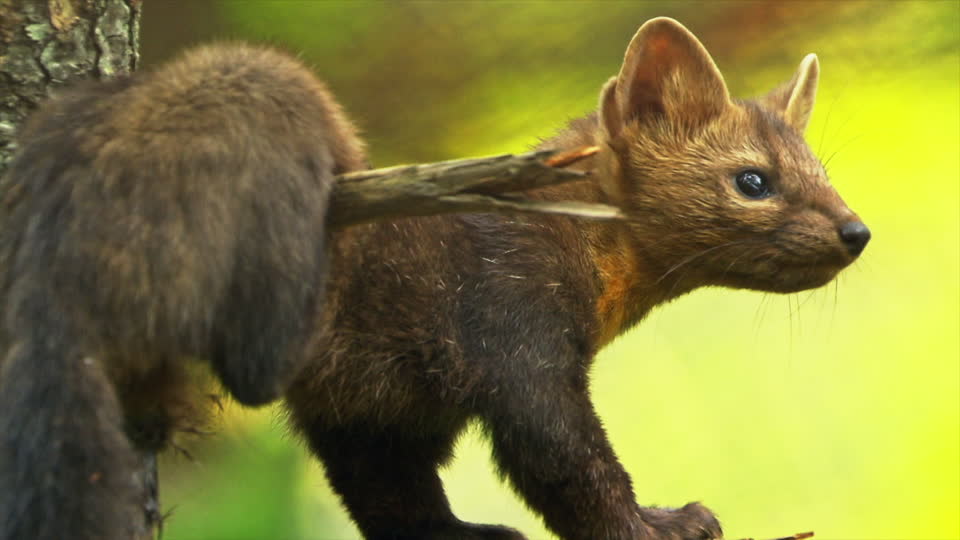
The sable (Martes zibellina) is a species of marten, a small omnivorous mammal primarily inhabiting the forest environments of China, Russia, from the Ural Mountains throughout Siberia, and northern Mongolia. Its habitat also borders eastern Kazakhstan, North Korea and Hokkaidō, Japan. Its range in the wild originally extended through European Russia to Poland and Scandinavia. Historically, it has been hunted for its highly valued dark brown or black fur, which remains a luxury good to this day. While hunting is still common in Russia, most fur on the market is now commercially farmed.
Sables inhabit dense forests dominated by spruce, pine, larch, cedar, and birch in both lowland and mountainous terrain. They defend home territories that may be anything from 4 to 30 square kilometres (1.5 to 11.6 sq mi) in size, depending on local terrain and food availability. However, when resources are scarce they may move considerable distances in search of food, with travel rates of 6 to 12 kilometres (3.7 to 7.5 mi) per day having been recorded.
10. Asian Elephant
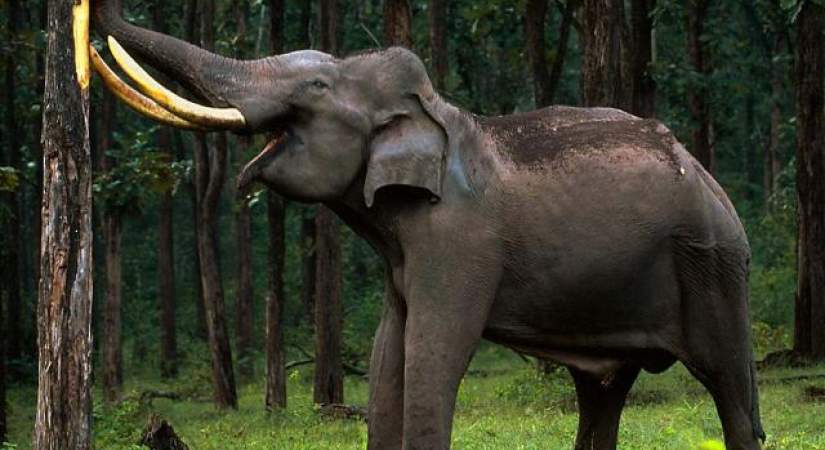
The Asian elephant (Elephas maximus), also called Asiatic elephant, is the only living species of the genus Elephas and is distributed throughout China, Indian subcontinent and Southeast Asia, from India in the west, Nepal in the north, Sumatra in the south, and to Borneo in the east. Three subspecies are recognised—E. m. maximus from Sri Lanka, E. m. indicus from mainland Asia and E. m. sumatranus from the island of Sumatra.
The Asian elephant is the largest living land animal in Asia. Since 1986, the Asian elephant has been listed as Endangered on the IUCN Red List, as the population has declined by at least 50 per cent over the last three generations, estimated to be 60–75 years. It is primarily threatened by loss of habitat, habitat degradation, fragmentation and poaching. In 2003, the wild population was estimated at between 41,410 and 52,345 individuals. Female captive elephants have lived beyond 60 years when kept in semi-natural surroundings, such as forest camps. In zoos, Asian elephants die at a much younger age; captive populations are declining due to low birth and high death rate.
The genus Elephas originated in Sub-Saharan Africa during the Pliocene and spread throughout Africa before expanding into the southern half of Asia. The earliest indications of captive use of Asian elephants are engravings on seals of the Indus Valley Civilisation dated to the 3rd millennium BC.